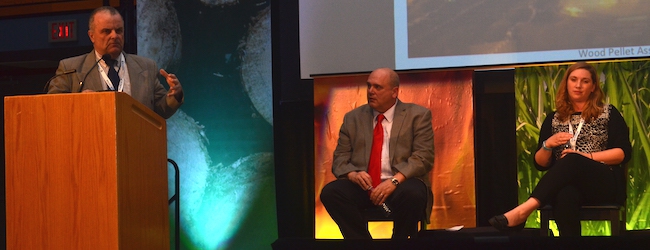
A global overview of the wood pellet market
June 17, 2016
By
Andrew Snook
June 16, 2016 – The final panel of the day at the International Bioenergy Conference and Exhibition offered an overview of the wood pellet market, moderated by Wood Products Association of Canada’s Gordon Murray.

Hawkins Wright research manager Louisa Blair started the session with a global wood pellet market overview. She stated that the pellet market has experience year-on-year growth over the past 15 years.
Europe remains the biggest producer and supplier of wood pellets at 51 per cent, with U.S. second at 27 per cent and Canada third at 7 per cent.
Overall demand increased for pellets increased by 13 per cent from 2014 to 2015.
The top 10 wood pellet-consuming countries were the U.K., easily leading the pack, followed by Italy, U.S., Denmark Germany, Sweden, South Korea, Belgium, France and Austria.
Canadian exports into Asia decreased overall in 2015, largely due to supply being displaced to Vietnamese producers. However, Japanese imports increased significantly over the year.
Blair said opportunities in Asia for Canadian producers include the Japanese market, due to their desire for long-term contracts, adding that imports to Japan ramped up significantly in last six months with Canada supplying the largest proportion of imports.
She added that there is currently oversupply in the market right now due to low oil prices and a warm winter that has created a spilling over of pellets from the residential sector into the industrial sector, which was already oversupplied. Although the growth of the residential pellet market has stunted, Blair adds that growth still remains positive.
John Arsenault, director of the Quebec Wood Export Bureau, also discussed the global market for wood pellets.
He discussed European production of pellets, which led by Germany at 2.1 million tons of wood pellets. Arsenault noted the impressive of growth of countries such as France, which went from essentially producing no pellets in 2004 to producing 1 million pellets in 2015. The smaller Baltic states and Russia have also become major producers of pellets, producing 4.15 million tons of pellets combined in 2014.
Pinnacle Renewable Energy’s senior vice-president of operations Scott Bax ended the session about considerations when using a variety of fibre residuals for pellet feedstock. He broke down residuals into three main categories: sawmill residuals, logging residuals and low-grade stands consisting of fire kill and mountain pine beetle-affected trees.
“Know your customer,” he told the crowd. “Not every residual is created equal or should be treated equally.”
Bax warned the crowd that it is extremely difficult to substitute one residual for another from both a production standpoint and for meeting customer expectations.
Print this page